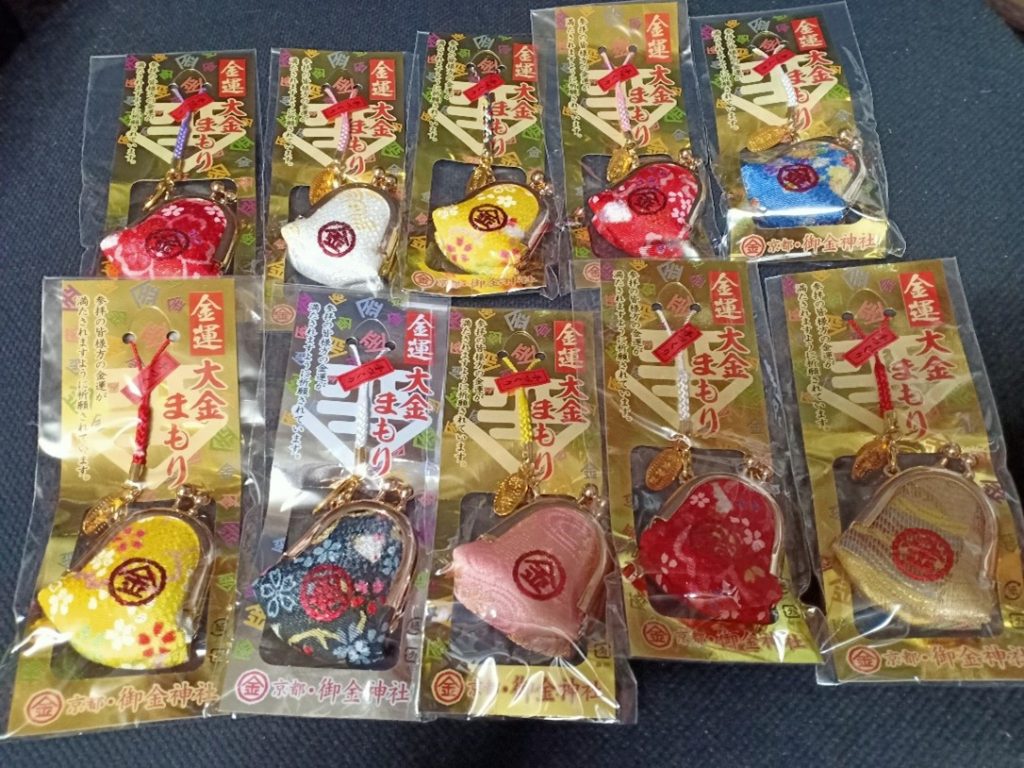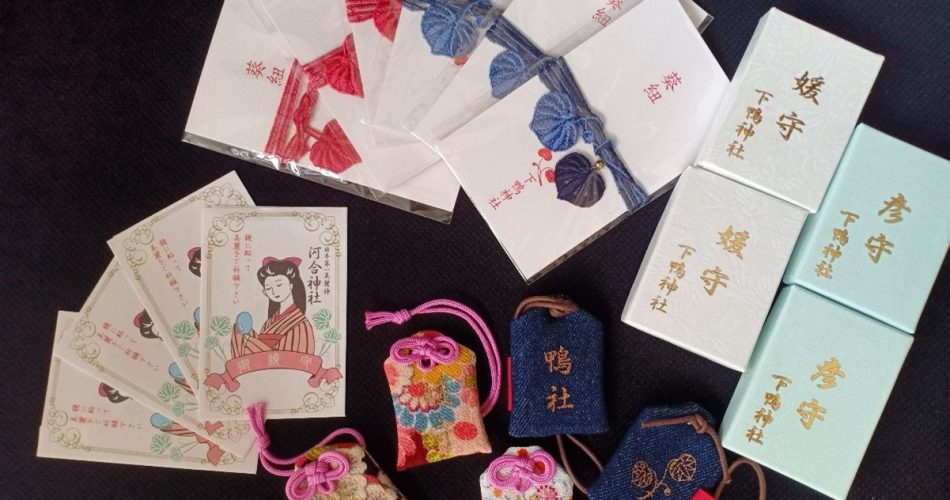Have you ever noticed arrays of colorful handmade fabric bags and small cute objects such as bracelets and cards displayed inside shrine vendors? They are called Omamori (amulets and talismans). It is common to see a long queue in front of waiting hours just to buy amulets. Japanese buy or make amulets whenever they pray for something. Omamori also has become a popular gift among people as a way to send their best regards to others. Why Omamori is typically wrapped in a fabric bag? Why do Japanese love to receive Omamori when they visit shrines? It might be a conceivable interpretation that they strongly believe in the Almighty God and invisible fortune that will facilitate their business, life and even love.

What is Omamori?
There are many words to describe an amulet in Japanese such as Omamori and Gofu. If you look up Omamori word in the dictionary, it is defined as “an object that protect you against evil spirits and disasters when you carry it or put it under your pillow”. For Gofu, the shrine or the Buddha names are usually weaved on the fabric or carved on a metal slip and put inside the amulet bags. It is often carried in a purse and sticked onto a wall to wish for God’s grace and protection. Most of the amulet fabric bags you encounter in shrines are Gofu. However, there is a general tendency to call all kinds of amulets Omamori without distinguishing between their purposes and shapes.

Where did Omamori originate?
There are three arguments for the origin of Omamori which are still a mystery until now. The first one said it was born due to one’s personal superstitious belief. The second one suggests that Omamori modeled after a freebie of Daoism-a religion arouse in China. The third one asserts that Omamori appeared as the rise of Buddhism in the second half of Heian Era. Many historians inclined to the third theory because the hanging amulets found in this period contained a wooden cylinder which was carved in the vein of the sacred Buddha statue standing in Shitennoji Pagoda in Osaka prefecture. There are also manuscripts stating that people in the past had a strong belief that stones and sands collected from pagodas and shrines could protect them from the devil and all. It is said that people started to carry Omamori as a trend in Kamakura Era. In this period, Samurai emerged and they were engaged in a lot of wars to conquer other lands. People also developed a custom of frequenting pagodas to hope for their survival and safely return.
Rules for Omamori
It is inappropriate to say “I want to BUY/SELL Omamori”. Omamori is spiritually not something that is for sale. It is better to say “I want to RECEIVE/GIVE Omamori”. If you understand Japanese, you would figure out that the place where Omamori are displayed in shrines are called Juyosho 授与所, which literally means granting place. Therefore, the act of reselling Omamori is strictly frown upon by shrines and pagodas because it would bring bad luck to both buyer and seller. It is also the reason why many shrines have restriction on the number of Omamori one person can receive so that they cannot open an amulet shop and make benefits from reselling it to other people. Another important point to keep in mind is that you should not open your Omamori bag because the God’s power will escape and Omamori will no longer be able to protect you. Moreover, some kinds of Omamori are effective in a certain time period (1 month, 1 year, etc.) so be sure to check this with the shrine/pagoda and get them disposed appropriately after this period passes. Do not tear or throw away your Omamori because it is an insult to God. You do not want to get bad luck all the time, do you?
Types of Omamori
Shrines and pagodas have their own designs and forms for their amulets. You hardly find exact two amulets from different shrines in Japan. They can have the similar look but the fabric, name and pattern obviously vary. In another word, amulets are unique to shrines and pagodas. They are generally classified based on their focuses: health, luck, prosperous business, money, love, traffic safety, travel safety, numerous offspring, thriving career, good grade, longevity etc. Some amulets are limited editions only available in festive periods or seasons. People regardless of nationality, religion and age can receive Omamori in any shrine and pagoda in Japan nowadays. Some shrines even establish an online website for Omamori granting via mail express for people who cannot visit the shrine but still want to receive Omamori. All you need to do is to fill in your name and address then Omamori will be sent to you several days later.

I asked several friends whether they own amulets or not. 25% said they own none, 0% own 1, 9% own 2, 16% own 3, 25% own 4 and 25% own more than 5. Here is the list of reason why they decided to receive amulets:
- For memory about the shrines they visited
- They feel safe when carrying amulets
- They believe in God
- They feel that their dream will come true thank to amulets
- They want to get good marks in school
- To fulfill their spiritual life
- Omamori looks cute
- …
It can be inferred that Japanese strongly believe in the power of God that can help them overcome obstacles in life and amulets play a supportive role in their spiritual mind. Not only in Japan, Asian people such as China, Thailand and Vietnam in general worship God. Amulets are also found in those countries. Recently, the number of Vietnamese who are interested in Japanese amulets is increasing because of their charming design, delightful color and above all, their miraculous “effect” that dominates misfortune. Many people have reported that after they received Japanese amulets, their business prospered incredibly, more luck came to their home and all the problems that they had been dealing with were solved completely. I have been collecting and giving away amulets to my family and friends and they were extremely happy to receive them. Amulets are easy to carry and explicitly show how caring I am towards them.
Next time when you visit a shrine and want to get some souvenirs for your family members and friends, why don’t you present them amulets as a testimonial and wish for health and luck? I bet that they will surely love these cute little objects that embody the Japanese cultural charms.
Reference:
・千々石到 (2010)「三 日本の護符の起源」千々石到『日本の護符文化』弘文堂 pp3 8-39


Comments